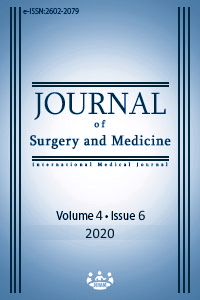The effect of tack number and balloon trocar use on acute post-operative pain scores of patients who underwent TEP repair of inguinal hernia
Keywords:
Tack number, Mesh fixation, Inguinal hernia, Laparoscopy, Post-operative painAbstract
Aim: As the novel technology on surgical procedures evolve, the management and amelioration strategies for postoperative pain gains importance for surgeons to improve patients’ life quality and postoperative outcomes. In this study, we aimed to compare the number of tacks placed during surgery and the use of intra-operative balloon trocars during TEP repair of inguinal hernias with respect to post-operative early pain scores.
Methods: A total of 83 patients were included in this prospective cohort study, 59 being in the 0-1 tack group and 24 in the 2 tacks group. Balloon trocar was used in 32 patients. All patients underwent laparoscopic TEP inguinal hernia repair. Groups were compared with respect to pain scores on 3rd, 12th and 24th postoperative hours.
Results: Pain score was better in no balloon trocar+2 tacks group when compared to balloon trocar+2 tacks and no balloon trocar+0-1 tack group at the 24th postoperative hour (P=0.02 and P=0.007, respectively), and in the balloon trocar+0-1 tack group than that of the no balloon trocar+0-1 tack group (P=0.004). There was no statistically significant difference between these four groups in terms of pain score on the 3rd and 12th hours of surgery (P=0.46 and P=0.24, respectively). Patients in the 0-1 tack group reported less pain on the 24th postoperative hour (3.1 (6.3) vs 14.1 (21.8); P=0.32).
Conclusion: Using less number of tacks and avoiding using balloon trocar result in lower pain scores following laparoscopic TEP repair of inguinal hernias.
Downloads
References
McCormack K, Wake B, Perez J, Fraser C, Cook J, McIntosh E, et al. Laparoscopic surgery for inguinal hernia repair: systematic review of effectiveness and economic evaluation.Health Technol Assess. 2005;9(14):1–203, iii-iv.
Bansal VK, Misra MC, Kumar S, Rao YK, Singhal P, Goswami A, et al. A prospective randomized study comparing suture mesh fixation versus tacker mesh fixation for laparoscopic repair of incisionaland ventral hernias. Surg Endosc. 2011;25(5):1431-8. doi: 10.1007/s00464-010-1410-6.
Rajapandian S, Senthilnathan P, Gupta A, Gupta PD, Praveenraj P, Vaitheeswaran V, et al. Laparoscopic totally extraperitoneal repair of inguinal hernia using twohand approach—A gold standard alternative to open repair. J Indian Med Assoc. 2010;108:652–4.
Kara Y. Comparative study of totally extra-peritoneal hernia repair versus open Lichtenstein hernioplasty for the treatment of primary inguinal hernia. J Surg Med. 2019;3(5):348-52.
Chowbey PK, Sharma A, Khullar R, Mann V, Baijal M, Vashistha A. Laparoscopic ventral hernia repair. J Laparoendosc Adv Surg Tech A. 2000;10(2):79-84. doi: 10.1089/lap.2000.10.79.
Ceccarelli G, Casciola L, Pisanelli MC, Bartoli A, Di Zitti L, Spaziani A, et al. Comparing fibrin sealant with staples for mesh fixation inlaparoscopic transabdominal hernia repair: a case control-study. Surg Endosc. 2008;22(3):668-73. doi: 10.1007/s00464-007-9458-7.
Bangash A, Khan N. Fixation in laparoscopic incisional hernia repair: Suture versus tacks. Journal of the Scientific Society. 2013;40(2):84-9. doi: 10.4103/0974-5009.115476.
DeMaria EJ, Moss JM, Surgerman HJ. Laparscopic intraperitoneal polytetrafluoroethylene (PTFE) prosthetic patch repair of ventral hernia. Surg Endosc. 2000;14:326–9.
Colak E, Ozlem N, Kucuk GO, Aktimur R, Kesmer S, Yildirim K. Prospective randomized trial of mesh fixation with absorbable versus nonabsorbable tacker in laparoscopic ventral incisional hernia repair. Int J Clin Exp Med. 2015;8(11):21611–6.
Belyansky I, Tsirline VB, Klima DA, Walters AL, Lincourt AE, Heniford TB. Prospective, Comparative Study of Postoperative Quality of Life in TEP, TAPP, and Modified Lichtenstein Repairs. Ann Surg. 2011;254(5):709-14. discussion 714-5. doi: 10.1097/SLA.0b013e3182359d07.
Gan TJ.Poorly controlled postoperative pain: prevalence, consequences, and prevention. J Pain Res. 2007;10:2287-98. doi: 10.2147/JPR.S144066
MacCallum RC, Browne MW, Sugawara HM. Power analysis and determination of sample size for covariance structure modeling. Psychological Methods. 1996; 1(2):130-49.
Misra MC, Bansal VK, Kulkarni MP, Pawar DK. Comparison of laparoscopic and open repair of incisional and primary ventral hernia: results of a prospective randomized study. Surg Endosc. 2006;20:1839-45.
Burger JW, Luijendijk RW, Hop WCJ, Halm JA, Verdaasdonk EGG, Jeekel J. Long-term follow-up of a randomized controlled trial of suture versus mesh repair of incisional hernia. Ann Surg. 2004;240:578–83.
Heniford BT, Walters AL, Lincourt AE, Novitsky YW, Hope WW, Kercher KW. Comparison of generic versus specific quality-of-life scales for mesh hernia repairs. J Am Coll Surg. 2008;206(4):638-44. doi:10.1016/j.jamcollsurg.2007.11.02.
Carbonell AM, Harold KL, Mahmutovic AJ, Hassan R, Matthews BD, Kercher KW, et al. Local injection for the treatment of suture site pain after laparoscopic ventral hernia repair. Am Surg. 2003;69:688-91.
Bansal VK, Asuri K, Panaiyadiyan S, Kumar S, Subramaniam R, Ramachandran R, cet al. Comparison of Absorbable Versus Nonabsorbable Tackers inTerms of Long-term Outcomes, Chronic Pain, and Quality of Life After Laparoscopic Incisional Hernia Repair: A Randomized Study. Surg Laparosc Endosc Percutan Tech. 2016;26(6):476-83.
Köckerling F, Bittner R, Jacob DA, Seidelmann L, Keller T, Adolf D, et al. TEP versus TAPP: comparison of the perioperative outcome in 17,587 patients with a primary unilateral inguinal hernia. Surg Endosc. 2015;29(12):3750-60. doi: 10.1007/s00464-015-4150-9.
Sajid MS, Ladwa N, Kalra L, Hutson K, Sains P, Baig MK. A meta-analysis examining the use of tacker fixation versus no-fixation of mesh in laparoscopic inguinal hernia repair. Int J Surg. 2012;10(5):224-31. doi: 10.1016/j.ijsu.2012.03.001.
Ip HY, Abrishami A, Peng PW, Wong J, Chung F. Predictors of postoperative pain and analgesic consumption: a qualitative systematic review. Anesthesiology. 2009;111:657–77.
Downloads
- 543 933
Published
Issue
Section
How to Cite
License
Copyright (c) 2020 Fatih Can Karaca, Deniz Atasoy
This work is licensed under a Creative Commons Attribution-NonCommercial-NoDerivatives 4.0 International License.
















